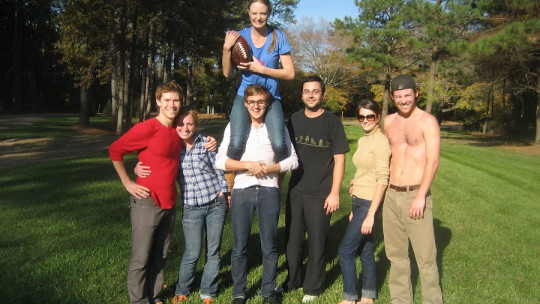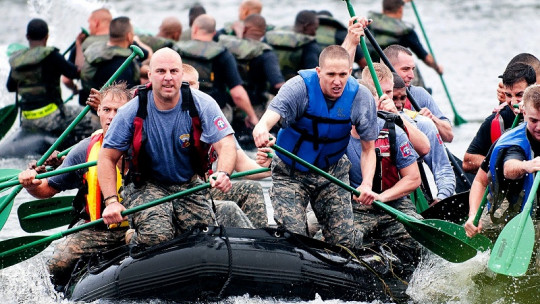
The dynamics of group integration They are methods used in groups to achieve an objective related to group cohesion, improving communication and/or training social skills. For this reason, they are used both in the educational world and in business, and even in therapy processes. They are activities that are beneficial, since they allow you to learn in a fun way and interact with other people.
The purpose of each dynamic may change, but the essential thing is that they allow camaraderie to be fostered while new knowledge is acquired or interpersonal relationships are improved.
In this article we are going to talk about its main characteristics, in addition to explaining some examples of dynamics used in groups of various ages In addition, at the end we will give you some advice on how to apply group integration dynamics, whether as an educator, as a team leader, or as a leisure and free time monitor.
Characteristics of group integration dynamics
Group integration dynamics are carried out with the intention of offering a lesson, whether moral, educational or companionship. Participants are asked to reflect on what they have done with the activity, and to explain how they feel.
Areas such as education and organizations are very popular, since they make it possible to improve relationships between students and workers, breaking down interpersonal barriers. Furthermore, they allow, in the educational case, to transfer theoretical knowledge to a more experiential field, favoring meaningful learning.

For a group integration dynamic to be carried out correctly, it is necessary that one or more facilitators be available These people are in charge of indicating the steps to follow, in addition to being the one who develops the dynamics after having studied the characteristics of the group where it will be applied.
Benefits of this type of games and group exercises
Although, as we have seen, these types of exercises can be adapted to many contexts and needs, There are a series of benefits and advantages of the application of group integration dynamics that characterizes them Let’s see what those reasons are why they are useful.
Examples of group integration dynamics
These are several examples of group integration dynamics for adults, children or adolescents.
1. My name is and my likes are
It is ideal to be used on the first day of kindergarten Its objective is to introduce the children and get them to know each other. Groups of about 10 children are recommended.
The facilitator begins by saying “My name is Juan and I like to play with my dog.” In an orderly manner, and starting from the same example, each child will introduce themselves and tell their tastes
Once all the children have spoken, the facilitator will ask if they remember the names of their classmates and will bring together those who have similar tastes.
2. Shared story
Children need motivation and to practice their creativity That is why this dynamic is perfect, since it involves creating a story all together.
The facilitator will begin the story, telling a story in which he appears and also in which one of the children appears, whom he will point to. The designated child will have to say his name and continue explaining the story. He will have to mention another child, he will point to him and thus continue telling the story.
It is highly recommended for kindergarten and primary school children. Ideally, the group should be about 8 or 10 people
3. Connection map
This is one of the best group integration dynamics for teenagers or adults, and it is relatively easy to apply.
Offer a sheet of paper and pens of three different colors to each participant. In the center of this, each person must write in a column four words that they consider define them or express their identity as an individual; Then, they must draw a circle around that column made of four elements.
Once this is done, each participant must go talk to the others, and both must select one of the words from the other person’s circle, write it down on their sheet of paper somewhere near the edge of the paper, and write a word that serves as “bridge” to conceptually connect both things. This exercise is ideal for finding common tastes, values or interests
4. Dreams
Is a dynamic widely used with adolescents and young people to teach them the importance that, despite difficulties, they should never stop pursuing their dreams.
It lasts about 15 to 25 minutes and it is recommended to do it with groups of between 10 to 20 participants. Balloons and chairs are needed, one for each participant.
At the beginning all the participants are sitting in a circle as close together as possible and must choose a dream. Each one inflates his balloon and pretends to introduce sleep into it
Then, they stand up and turn their chairs to form a very small circle, within which they are. The balloon must reach as high as possible. The facilitator has an object, such as a pellet gun, to pop any balloons that come out of the circle.
The idea of this dynamic is understand that it is necessary to leave the comfort zone to achieve your dreams, but there will always be someone who tries to destroy them.
5. Closed backs
This dynamic encourages teamwork and lasts approximately between 10 and 25 minutes. The number of participants is very varied and can range from 2 to 40 people.
Two participants, for example, sit on the floor with their backs to each other and hold each other’s arms without turning. The idea is that they stand up using strength between themselves but without resting their hands on the ground.
It is important that, to get couples, their members have more or less the same physical build height and that they do not have back problems.
The fundamental learning in this dynamic is that by joining efforts, great milestones can be achieved.
6. Sum of teams
It lasts about 20 minutes and requires between 10 and 20 people. Sheets with numbers from 0 to 9 are needed.
There needs to be at least two groups in which each person receives one or two sheets with numbers.
The facilitator says a multi-digit number out loud and the groups have to form it with their sheets of paper. The group that forms the number first wins the point
Numbers can be said directly (eg: 45) or a mathematical formula (eg: 10×10:2-10+5).
Mathematical abilities are tested interactively and a sense of sportsmanship is promoted
7. The mirror
It is an ideal dynamic to improve confidence between children, in addition to helping them reflect on their emotions.
The facilitator forms pairs of children, who will face each other One of them will make movements and the other will imitate him.
Empathy is promoted, since they are free to imitate their partner but they must do so in a way that is not humiliating. Timing, coordination and concentration are also tested.
8. The wrong message
Ideal for teenagers and young adults. It is fun and allows you to reflect on the transmission of information in a chain of several interlocutors.
The participants line up The first person in line is the one who receives the message directly from the facilitator. The first in line will tell the message to the second, and the second to the third, and so on.
The last one must say out loud the message that has arrived. The facilitator will compare what he had said at the beginning with what he has reached at the end.
With this dynamic, the memory of the participants, their attention span and your communication skills
9. Arming the word
This activity makes it easier for members to interact and get to know each other.
The facilitator will distribute sheets with written letters Each participant will have a sheet and will not know what letters the others have.
The facilitator has chosen those letters to form a word, and it is the participants who must figure out what it is. Besides, rules can be set such as that they should introduce themselves every time they talk to someone.
10. The most questioning ball
It is ideal for working with small groups. You need a ball and a music player
The children form a circle and, when playing music, the ball is passed from one to another. When the music stops, the person who has the ball must say its name and ask the others a short question.
The other classmates must answer before the music plays again When the music plays again, the ball will be in motion again. The game will last until everyone has shown up.
11. Muddy river
The participants are sitting in a circle and in their hands they have bottle caps. A song is sung: “very cloudy, cloudy water passes through the river.” With the caps they must follow the rhythm of what they sing. At each time the cap must be passed to the partner on the right.
The song gets faster and faster. Those who lose their rhythm are eliminated until only three remain. The last three participants will require very good coordination to continue doing the activity.
In this dynamic camaraderie, coordination and synchronization are practiced
12. Collective drawing
This is one of the best group integration dynamics for work teams and companies, and the essence of the activity is well expressed in its name. It simply consists of making a drawing collectively; It is advisable to ask them to draw an element associated with the world of construction or engineering, such as a building, a house, a castle, etc.
In turns and in several rounds, Each person must contribute their ideas and creativity in creating on paper what you must draw as a team, drawing lines or coloring with a marker in a color that no one else has, so that it is easy to visually appreciate who has done what. In the last round of turns, with everyone standing in a circle around the paper (or in front of it if it is a small group), each member of the team must draw the person on their right representing them carrying out some constructive activity in the fictitious structure that you have created. .
How to apply group integration dynamics?
Follow these tips and steps to follow if you want to adopt the role of facilitator of this type of group exercises.








